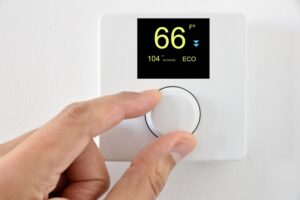 An air conditioner can often seem like a magical device. We understand how we get heat from furnaces and fireplaces—combustion gives off warmth. But an AC is a box or set of boxes that somehow creates cool air, the opposite of fire. Because an air conditioner can feel like a remarkable device, people might treat them as if they don’t have limits. They can cool a house down as much as necessary.
An air conditioner can often seem like a magical device. We understand how we get heat from furnaces and fireplaces—combustion gives off warmth. But an AC is a box or set of boxes that somehow creates cool air, the opposite of fire. Because an air conditioner can feel like a remarkable device, people might treat them as if they don’t have limits. They can cool a house down as much as necessary.
Of course, air conditioners aren’t magic, and they do have limits. An AC cools a house by moving heat from the indoor air and exhausting it outside, and there is a capacity to how much heat an air conditioner can draw from a house. We’re going to talk about the limits of your air conditioning system and how it affects the way you cool your home.
The Air Conditioner’s Temperature Differential
If you look at the thermostat for your home, you’ll see that the lowest temperature setting is 60°F (sometimes 65°F). But this isn’t the AC’s limit; that’s just how low the temperature sensor in the thermostat can be lowered. The actual limit of your AC is called its temperature differential, which is how much the AC can cool the air indoors compared to the temperature outdoors.
For standard central air conditioning systems, the temperature differential is 20°F. Let’s imagine a standard hot day in July here in Colorado Springs. It’s 85°F outside, so how cool can your AC make the house? With a temperature differential of 20°, it can lower the house’s temperature to 65°F—which is honestly far too cold for most people. To save energy, we recommend a setting of 78°F, which most people will find is cool enough if they have light clothing on. That setting is well within the 20°F differential and the AC won’t struggle to meet it.
It doesn’t happen here often, but what about days when the outdoor temperature is 100°F? In that case, the AC couldn’t lower the temperature below 80°F, so that would be the best setting for it. Although a 78°F setting wouldn’t be terrible—the AC would run longer, probably only shutting down when the outside cools off a bit—anything much lower could be bad news, because it would put far too much strain on the AC. Such low settings on the AC can even cause the system to freeze up with frost forming on the coils. We strongly warn against putting the thermostat lower than 68°F when you’re running the AC.
If Your AC Isn’t Getting the Job Done…
As you can see, we’re in a good situation here in Colorado Springs when it comes to cooling off in summer: even our heat waves won’t force air conditioners to push past their limits, and smart thermostat settings are easy to do. But if you’re following this advice and yet the AC doesn’t keep your house comfortable, you probably need the help of a Colorado Springs, CO, HVAC professional. Let our technicians find out why your AC is falling behind on its cooling job.
Call Robbins Heating & Air Conditioning for 24-hour emergency service when you have AC troubles.
